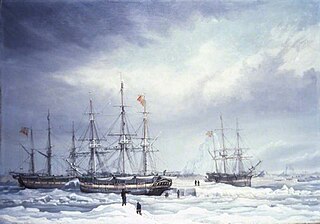
HMS Hecla was a Royal Navy Hecla-class bomb vessel launched in 1815. Like many other bomb vessels, she was named for a volcano, in this case Hekla in southern Iceland. She served at the Bombardment of Algiers in 1816. Subsequently, she took part in three expeditions to the Arctic. She then served as a survey vessel on the coast of West Africa until she was sold in 1831. She became a merchantman and in 1834 a Greenland whaler. She was wrecked in 1840.
Duke of York was a three-masted brig launched in 1817 at Bideford as a Falmouth packet, sailing between Falmouth, Cornwall, and Jamaica. In 1836 she brought settlers to South Australia for the South Australia Company. She was wrecked in 1837.
Edward Lombe was a merchantman and passenger three-masted barque built in 1828 by Thomas Brodrick, of Whitby, England.
Cumberland was launched at Holyhead in 1826 as a steam packet. In 1839 she underwent conversion to a sail barque. In 1846 Cumberland transported Parkhurst apprentices to the Swan River Colony. She foundered on 23 October 1849 while carrying rice from Bally, Netherlands East Indies, to Hong Kong.
Tam O'Shanter was a sailing ship built in 1829 in North Hylton. In 1830 she sailed to India under a license from the British East India Company (EIC). Next, she was a West Indiaman, sailing to Bermuda and Jamaica. She then played a role in the founding of Adelaide in 1836. Tam O'Shanter ran aground in 1837 off Tasmania and was considered a write-off.
True Briton was launched at Pont Neuf, Quebec, in 1811. Her primary trade was sailing between Britain and New Brunswick, but she also sailed to Jamaica, and made two voyages to India. Her crew abandoned her in the Atlantic in 1822.
Andrew Marvel was launched at Hull in 1812. From 1812 to 1835 she was a Greenland whaler, hunting bowhead whales in the northern whale fishery. Thereafter she became a merchantman. She foundered in September 1843 while on a voyage from Hull to Saint John, New Brunswick.
Woodlark was launched at Moulmain in 1832. Circa 1835 she sailed to London and transferred to British registry. Between 1836 and 1844 she made two whaling voyages. In 1848 she transferred her ownership and registry to Sydney, from where she continued to sail for some time. She briefly appeared and was last listed as being in New Zealand in 1890–1891.
Harriet was launched at Yarmouth in 1836. Between 1836 and 1840 she may have made one voyage as a whaler in the British southern whale fishery. She burnt in 1842.
Ganges was launched at Calcutta in 1806. In 1807 or 1809 a French privateer captured her. The British Royal Navy recaptured her the next year. She assumed British Registry in 1812, but had traded out of London since late 1810 or early 1811. By 1820 she was trading between London and Bengal. She was last listed in 1846.

Jane was launched at Kingston upon Hull in 1813 as a West Indiaman. Between 1818 and 1836 she was a whaler in the northern whale fishery. She then became a merchantman and was wrecked in 1866.
Medusa was launched at Whitby in 1813. She spent a number of years as a transport, but from the mid-1820s on she sailed between England and Canada. She was abandoned in a sinking state on 1 January 1834.
Bardaster was launched in New Brunswick in 1833. She spent her career sailing between England and Australia and New Zealand. She transported convicts to Tasmania in 1835–1836, and was broken up in 1840.

Africaine, was a barque launched in 1831 at Jarrow on the River Tyne in England. In 1836 she carried immigrants as part of the First Fleet of South Australia. She was wrecked on 23 September 1843.
Harriet was a former vessel of the British Royal Navy, probably the Cruizer-class brig-sloop HMS Harrier. The Navy sold her in 1829 and her new owners deployed her as a whaler in the British Southern Whale Fishery. She made three complete whaling voyages and was wrecked in July 1837 during her fourth.
Wanstead was launched in 1826 at St John, New Brunswick. From 1826 on she sailed from England, first as a West Indiaman. She made two voyages transporting passengers to Tasmania, one voyage in 1827–28, and the other in 1829–30, stopping at the Swan River Colony. Between 1831 and 1837 she made one voyage as a whaler, catching whales off Japan, and New Zealand. She then returned to trading with the West Indies. Her crew abandoned her at sea in September 1843.
Dowson was launched in Hull in 1807 as a West Indiaman. She quickly became a transport and then made one voyage to New South Wales. Later she traded with North America. She underwent two maritime mishaps that she survived, one in 1807 and one in 1821. Her crew abandoned her in the Atlantic Ocean on 19 October 1836.
Christopher was launched in Lancaster in 1809. She sailed as a West Indiaman until 1816 when she sailed to India under a licence from the British East India Company. On her return she returned to the West Indies trade. Later she started trading between London and Quebec. She was wrecked at sea on 5 December 1836.
Thetis was launched in 1793 in Rotherhithe. She spent most of her career as a West Indiaman. She spent several years as a government transport, and then between 1830 and 1836 she made two voyages as a whaler in the Britishsouthern whale fisheryy. She returned to trading to the western hemisphere, and was last listed in 1842.
Prince Regent was launched at Howdon Pans in 1811, the last vessel that the shipbuilding firm of Francis Hurry & Co. built. She spent almost all her career as a West Indiaman. New owners circa 1834 started trading with the Baltic. She was wrecked on 31 October 1836, forcing her crew to abandon her.


